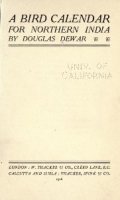Another extract from Douglas Dewar’s A Bird Calendar for Northern India, published in 1916 in which he describes the month of May:
| May in the plains of India!…It is in this month of May that the European condemned to existence in the plains echoes the cry of the psalmist: “Oh that I had wings like a dove! for then would I fly away, and be at rest”—in the Himalayas. There would I lie beneath the deodars and, soothed by the rustle of their wind-caressed branches, drink in the pure cool air and listen to the cheerful double note of the cuckoo.
It is true that the gold-mohur trees and the Indian laburnums are in full flower and the air is heavily laden with the strong scent of the nim blossoms. The pipal trees…now offer to the birds a feast in the form of numbers of figs… This generous offer is greedily accepted by green pigeons, mynas and many other birds which partake with right goodwill and make much noise between the courses. The birds do not object to the heat. They revel in it…The breeding season is now at its height… the man who remains in one station, if he choose to put forth a little energy and defy the sun, may reasonably expect to find the nests of more than fifty kinds of birds. The most notable performers are the cuckoos. These birds are fully as nocturnal as the owls. The brain-fever bird* (Hierococcyx varius) is now in full voice,the eternal “brain-fever, brain-fever, BRAIN-FEVER,” each “brain-fever” being louder and pitched in a higher key than the previous one, until the bird reaches its top note… the Indian cuckoo (Cuculus micropterus)…dwells chiefly in the Himalayas, but late in April or early in May certain individuals seek the hot plains and remain there for some months. The call of this cuckoo is melodious and easily recognised. Indians represent it as Bouto-taku…To the writer’s mind the cry is best represented by the words wherefore, wherefore, repeated with musical cadence. In the case of the blue-tailed bee-eaters the nesting season is now at its height… The Indian oriole# (Oriolus kundoo) lays from two to four white eggs… Both sexes take part in nest construction, but the hen alone appears to incubate. May and June are the months in which to look for the nests of that superb bird—the paradise flycatcher (Terpsiphone paradisi). This is known as the rocket-bird or ribbon-bird because of the two long fluttering tail feathers possessed by the cock. The hen has the appearance of a kind of bulbul, being chestnut-hued with a white breast and a metallic blue-black crest. For the first year of their existence the young cocks resemble the hens in appearance. Then the long tail feathers appear. In his third year the cock turns white save for the black-crested head. This species spends the winter in South India. In April it migrates northwards to summer in the shady parts of the plains of Bengal, the United Provinces and the Punjab, and on the lower slopes of the Himalayas. The nest is a deep, untidy-looking cup, having the shape of an inverted cone. It is always completely covered with cocoons and cobweb. It is usually attached to one or more of the lower branches of a tree. Both sexes work at the nest and take part in incubation. The long tail feathers of the sitting cock hang down from the nest like red or white satin streamers according to the phase of his plumage. In the breeding season the cock sings a sweet little lay—an abridged version of that of the fantail flycatcher. When alarmed both the cock and the hen utter a sharp tschit. Even as April showers in England bring forth May flowers, so does the April sunshine in India draw forth the marriage adornments of the birds that breed in the rains. |
* Also called: Common Hawk-cuckoo.
# Also called: Eurasian Golden Oriole.
Taken, with grateful thanks, from Project Gutenberg.

